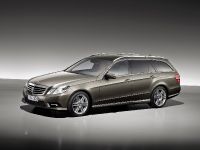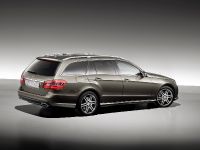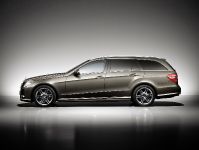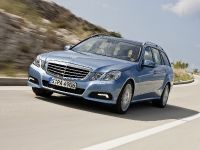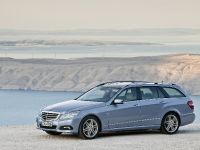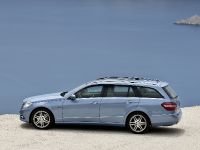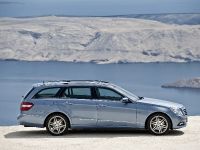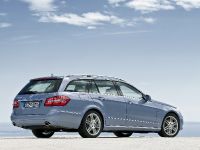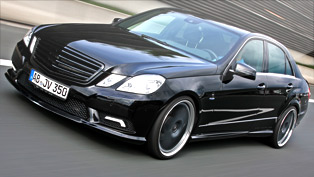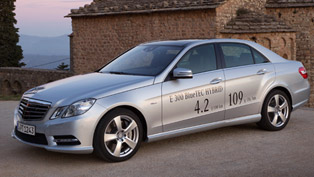Mercedes-Benz E-Class Estate
From November 2009, Mercedes-Benz is launching the Estate version as another highly distinctive member of the E-Class family. Like the Saloon and Coupé, the Estate, which is available now, combines unique design with leadership in safety, comfort, quality and practicality. The new E-Class marks the debut of a number of technical innovations which no other car in the world in this category is able to offer - from drowsiness detection to automatic emergency braking when an accident is recognised as imminent, and from Adaptive Highbeam Assist to the Active Bonnet. Naturally the Estate also features all these innovations. Plus air suspension with self-levelling at the rear as standard and unique new load compartment management features.
The E-Class Estate is seen as the progenitor of the premium lifestyle estate segment more than 30 years ago. Since the launch of the first Estate in 1977, more than one million customers have discovered their enthusiasm for this most practical way of driving a Mercedes luxury car. This success story is set to be continued by the fifth generation of the E-Class Estate – following up on the successful launch of the Saloon. Only introduced in Europein spring 2009, the E‑Class Saloon had already achieved world-wide market leadership in its segment by May 2009. Some 40,000 new E-Class models have now been delivered to customers.
The performance of the Saloon and Coupé in the 2009 AutoBild Design Awards shows how well the striking lines of the E-Class have been received: more than 100,000 readers of this German motoring publication recently voted the four-door model the most beautiful car in the world, and gave the two-door model first place in the Coupé/Cabriolet category.
Design: new Mercedes hallmarks combined with E-Class styling features
The new Estate immediately makes an athletic and practical, but also effortlessly superior and safe impression. Its distinctive design character is based on the new Mercedes style, which had its debut in the S-Class and is now also represented in the C-Class. One of its main features is the interplay between concave and taut surfaces, which are delimited by dynamic edges and structured contours.
The side view reveals many new elements, leaving no doubt about the identity of the new Estate. The B- and C-pillars appear to merge into the background thanks to glossy, black trim panels, making the entire side window area look like a single entity. This leads to a taut arch leading from the filigree A-pillar to the dramatic roof line and the downward-tapering D-pillar, all resting on the athletic shoulder line of the Estate. The intriguing design of the door sill panels, which are visually understated in the centre but feature a prominent light-catching contour towards the wheel arches, accentuates the dramatic overall effect of the side aspect. This is additionally emphasised by the muscular, sweeping line on the rear side panel in front of the rear wheel.
When shaping the rear end, the Mercedes designers took care to give expression to the high practicality of the new model. They did this by emphasising horizontal lines, for example the band formed by the tail lights and the chromed tailgate handle. The new LED tail lights are based on a two-piece design, and create a visual continuation of the side wall into the tailgate. Both by day and night, their distinctive design is a major recognition factor for the E-Class Estate. This is the largest estate car in the premium segment, and it makes no secret of the fact.
Practicality: top marks for load capacity and ease of operation
One particularly special feature of the load compartment management system is the option of opening the standard-fit EASY-PACK tailgate automatically by using the ignition key or pressing the handle if the car needs to be loaded from behind. The innovative "quickfold" system enables the rear seat backrests to be folded down from the load compartment. Neither the head restraints nor the rear-seat cushions need to be adjusted beforehand in order to be able to do this. The two backrest sections are unlocked and folded down by a cable pull, creating a level loading surface. As another useful feature, either the left or right backrest sections, or both together, can be folded down. This enables the rear seat unit to be used by passengers even when long and bulky items are being carried. The backrest sections can also be unlocked and folded down from the side.
It is now also much easier to use the combined luggage compartment cover and retaining net, which is attached at beltline level for the first time, making it far simpler to install and remove in various positions.
With a load capacity of up to 1950 litres, the new E-Class Estate (length/width/ height: 4895/1854/1471 millimetres) sets the standard in its class. Apart from the load compartment capacity itself, other dimensions of great practical importance – such as the rear aperture, load compartment sill and maximum load compartment length – demonstrate the expertise of Mercedes-Benz when it comes to estate car engineering.
It is not only in the load compartment that the generous dimensions of the preceding model have been improved even further in many respects. Two examples in the interior illustrate this: the elbow width in the rear has been increased by 50 millimetres to 1505 millimetres. Rear headroom with the large tilting/sliding sunroof installed has also improved by 50 millimetres to 1010 millimetres, and is almost as generous as in versions with no sunroof (1012 mm).
An exemplary load management system is specified as standard. For example, the automatically opening and closing EASY-PACK tailgate with automatic raising of the load compartment cover, or the EASY-PACK folding load compartment floor. The latter considerably increases the usable height of the load compartment. It can be folded up and secured in various positions. Standard equipment also includes the EASY-PACK load compartment cover with a load securing net. When extended, the load compartment cover can be hooked into electrically powered carriers on the D-pillars. When the tailgate is opened, the load compartment cover is automatically raised to allow unobstructed loading and unloading. The optional folding bench seat for the load compartment is also unique in this vehicle segment.
Safety: nine airbags as standard, plus innovative driver assistance systems
Mercedes-Benz has consolidated its leadership in safety even further with the new E-Class. Around one dozen new or modified driver assistance systems help to prevent road accidents or at least reduce the severity of the impact. These include the standard ATTENTION ASSIST drowsiness detection system, the optional DISTRONIC PLUS proximity control and the optional PRE-SAFE® Brake, which is able to initiate partial and full emergency braking autonomously. For the first time, PRE-SAFE® is also able to use only the information received from the short-range sensors in the front bumper to tension the front seat belts at the last moment before an accident recognised as unavoidable, thereby reducing the loads exerted on the driver and front passenger during the crash.
With nine airbags fitted as standard, four belt tensioners and belt force limiters, and NECK-PRO crash-responsive head restraints for the driver and front passenger, the new E-Class offers an even more extensive package of safety equipment than its predecessor. The airbags, which can deploy in a matter of milliseconds in the event of an accident, include two adaptive airbags for the driver and front passenger, a kneebag for the driver, two sidebags in the front-seat backrests and two large windowbags which extend from the A-pillar to the C‑pillar during a side impact. Pelvisbags for the front occupants are also included for the first time. These reduce the loads acting on the torso and pelvic area during a lateral collision.
Sidebags for the rear seat passengers can also be installed as optional extras. As a further safety innovation, Mercedes-Benz also offers optional, self-adaptive belt force limiters for the rear. These adjust to the size and weight of the passengers, and also become available for the Saloon with the introduction of the Estate.
Suspension: automatic self-levelling at the rear as standard
Outstanding comfort on long journeys in the Estate is ensured by the newly developed DIRECT CONTROL suspension, which features the adaptive damping system as standard. The likewise standard self-levelling rear suspension sees to it that the Estate always remains at the same level, even when fully laden. The Estate's suspension setup has also been adapted to suit the modified body geometry, with slightly stiffer shock absorber settings and torsion bar stabilisers, making the Estate just as agile as the Saloon without having to make compromises in terms of road roar and tyre vibration characteristics.
Engines: considerable reduction in fuel consumption and emissions
The fuel consumption and emissions of the new Estate have been considerably reduced by new engines and numerous optimisation measures (aerodynamics, weight, energy management, reduced resistances). One prime example is the E 250 CDI with an output of 150 kW and a peak torque of 500 Nm, whose fuel consumption is only 5.7 litres per 100 km, with CO2 emissions of 150 g per km.
The engine line-up available for the new Estate at launch comprises five units developing between 125 kW/170 hp and 285 kW/388 hp. Though with a lower displacement, the new and modified engines generate more output than their predecessors, while impressing with fuel consumption figures that were previously only found in the compact class. This was made possible by numerous innovations, for example spray-guided direct injection for the E 350 CGI BlueEFFICIENCY petrol model. The four-cylinder CDI engines partly owe their exceptional status to newly developed piezo injectors and two-stage turbocharging. All the powerplants meet the requirements of the EU5 emission standard. The E-Class Estate can be ordered now. All of the engines available at launch, the accompanying transmissions installed as standard and the basic prices at a glance:
Diesel
- E 220 CDI BlueEFFICIENCY: 4-cylinder in-line, 2143 cc, 125 kW/170 hp, 5.7-5.8 l per 100 km, CO2 150-153 g/km, 6-speed manual transmission, from € 44,803.50
- E 250 CDI BlueEFFICIENCY: 4-cylinder in-line, 2143 cc, 150 kW/204 hp, 5.7-5.8 l/100 km, CO2 150-153 g/km, 6-speed manual transmission, from € 47,719
- E 350 CDI BlueEFFICIENCY: V6, 2987 cc, 170 kW/231 hp, 7.0-7.3 l/100 km, CO2 185-192 g/km, 7-speed automatic transmission, from € 54,204.50
Petrol
- E 350 CGI BlueEFFICIENCY: V6, 3498 cc, 215 kW/292 hp, 8.6–8.9 l/100 km, CO2 200-208 g/km, 7-speed automatic transmission, from € 55,156.50
- E 500: V8, 5461 cc, 285 kW/388 hp, 11.1–11.2 l/100 km, CO2 258-260 g/km, 7-speed automatic transmission, from € 70,150.50
The following additional models are available from the first quarter of 2010 onwards:
Diesel
- E 200 CDI BlueEFFICIENCY: 4-cylinder in-line, 2143 cc, 100 kW/136 hp, 5.7* l/100 km, CO2 150* g/km, 6-speed manual transmission, from € 41,947.50
- E 350 CDI 4MATIC BlueEFFICIENCY: V6, 2987 cc, 170 kW/231 hp, 7.6–7.7 l/100 km, CO2 200-203 g/km, 7-speed automatic transmission, from € 56,941.50
Petrol
- E 200 CGI BlueEFFICIENCY: 4-cylinder in-line, 1796 cc, 135 kW/183 hp, 7.7* l/100 km, CO2 179* g/km, 6-speed manual transmission, from € 42,721
- E 250 CGI BlueEFFICIENCY: 4-cylinder in-line, 1796 cc, 150 kW/204 hp, 8.0-8.2 l/100 km, CO2 185-191 g/km, 5-speed automatic transmission, from € 47,719
- E 350 4MATIC: V6, 3498 cc, 200 kW/272 hp, 10.2-10.3 l/100 km, CO2 238-241 g/km, 7-speed automatic transmission, from € 56,941.50
